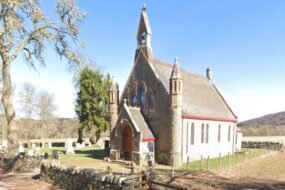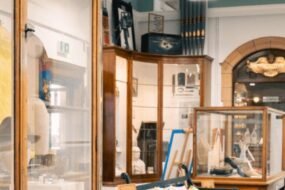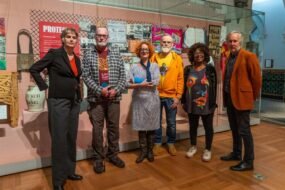
Robert O’Byrne is more au fait than most with the concept of the Kunstkammer, or cabinet of curiosities, a room or suite of rooms that houses a collection of artworks, antiquities, relics, natural specimens and other objects of interest. The author of and among other books, he also hosts the website, theirishaesthete.com, where he blogs on architecture and the arts.
Kunstkammer, the lead exhibition at Lismore Castle Arts in Co Waterford this summer, could hardly have had a better qualified curator.
Lismore Castle is the Duke of Devonshire’s Irish estate, O’Byrne explains. “It’s run by his son and daughter-in-law William and Laura Burlington. When they asked me to curate, they already had the theme. It suited me perfectly; the Kunstkammer is a subject I’ve always been very interested in, so it’s been a very happy marriage.”
O’Byrne was free to select as he wished, the only condition being that he would include work by contemporary Irish and international artists. “That wasn’t a difficult thing to do,” he says. “We have pieces by Dorothy Cross and Alice Maher, along with Joseph Walsh. He’s an extraordinary woodman, for want of a better term. He had two wonderful, very sinuous cabinets that he’d made for a Chinese client, but he postponed sending them off to Hong Kong so they could be shown at Lismore.
“Another Irish artist, Patrick O’Reilly, has produced these bronze bowls, with lumps of different coloured glass from Murano outside Venice in them. They’re almost like a modernist three dimensional version of cubist fruit bowls, and they sit on the shelves inside Joseph’s cabinets.”

Sasha Sykes, who is based in Co Wicklow, is also in the show. “Sasha collects plants and flowers, and preserves them in layers of resin. For this exhibition, I asked her to make a sort of treasure chest with a curved open lid, and it incorporates plants and flowers from the gardens at Lismore Castle. They’re the oldest continuously cultivated gardens in Ireland, going back over 400 years.”
One of the best known artists in the exhibition is Sarah Lucas, one of the Young British Artists who came to prominence in the late 1980s. “We have a couple of Sarah’s recent sculptures,” says O’Byrne. “Monster Chetwynd is another British artist, who makes these extraordinary three-dimensional moths and strange animals; we’ve got a couple of those in the show as well.” O’Byrne also invited a French artist named Aurél to participate.
“I came across his work on Instagram. He makes these extraordinary sculptures – I’d describe them as Hindu Gothic – out of Lego. He made two pieces especially for the exhibition, and facing them are a pair of 18th century gilt Rococo Irish mirrors, which have equally elaborate frames. You can look into those and see Aurél’s sculptures on the opposite wall. There’s an interesting synergy and interaction between the two pairs of works from different periods.”
The exhibition is full of such unlikely juxtapositions. One of Lucas’s rather crude figurative sculptures, for instance, dangles from the ceiling near an elegant 350-year-old copy of the Neapolitan apothecary Ferrante Imperato’s book Dell’Historia Naturale, which describes the cabinet of curiosities he assembled at the Palazzo Gravino in the late 16th and early 17th centuries.
“You might ask what these artworks and objects have in common,” says O’Byrne. “Not a lot, except that I thought they were all rather wonderful and I devised various means to have them as a kind of thread that you wander through in the gallery.”
O’Byrne has form as a provocateur. The title of his website, The Irish Aesthete, has the subheading, ‘This is not an Oxymoron’.

“That’s a giant tease,” he says. “It always manages to infuriate people.” He was, he says, very lucky to have come from a family that appreciated culture. “I grew up in the Middle East. My father worked out there in the oil business. I was mostly schooled in England, and then I came to Ireland and went to Trinity and stayed. Growing up, it was second nature to go to art galleries, museums, the theatre and opera. I just took that for granted.”
He began writing after college, for Apollo and Burlington magazines and the Irish Times. He has also produced more than a dozen books, which range from a biography of the art collector Hugh Lane to a number of guides on gentlemen’s grooming and deportment. He launched The Irish Aesthete website, and persona, 13 years ago.
“I don’t know why on earth I started it,” he says. “Writing a blog gives you a certain freedom, but you also have a responsibility to your readers. I sometimes refer to the blog as ‘the hungry child,’ as I have to keep feeding it new material and it takes up so much of my time. But on the other hand, it has proven to be a remarkably, unexpectedly successful calling card. Almost anywhere I go, within a certain milieu – that is to say, architects, historians, that kind of thing – they all know who the Irish Aesthete is.
“Apart from the website, I post on Instagram, where I have just shy of 40,000 followers. So I suppose I can claim to be an influencer.”
He is, he says, very pleased with the reaction to the Kunstkammer exhibition. “I was back in Lismore a few weeks ago, and I was very happy to see so many visitors being fascinated by the strange and wonderful exhibits. In the 15th and 16th centuries, these displays were called either Kunstkammer, which is an art cabinet, or Wunderkammer, which is a wonder cabinet.
“So this is a modern spin on what is a very old exhibition concept. It’s good to know that people are still capable of wonder.”
- Kunstkammer runs at Lismore Castle Arts until October 26 Further information: lismorecastlearts.ie









